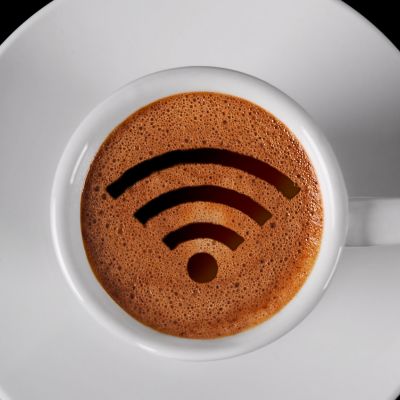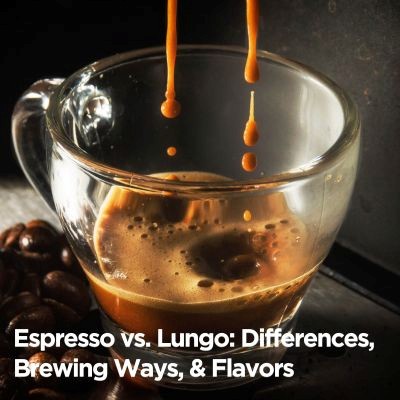Did you know that pour-over coffee has significantly increased in popularity over the past decade? In Singapore, the specialty coffee scene has grown remarkably.
The trend is just starting, with an increase in the number of cafes offering pour-over coffee in the last five years, and citizens are ready to pay up to S$85 for a cup of specialty coffee.
This brewing method is often associated with the third wave coffee movement, which emphasizes high-quality, artisanal coffee.
Pour-over coffee allows enthusiasts to have complete control over the brewing process, resulting in a cup of coffee that highlights the unique flavors of the beans.
This article explores everything you need to know about pour-over coffee, from the equipment required to the step-by-step brewing process and best practices for achieving the perfect cup.
What is Pour-Over Coffee?
What is Pour-Over Coffee? It is a manual brewing method in which hot water is slowly poured over coffee grounds and placed in a pour-over coffee filter.
This process allows the water to extract the flavors from the coffee grounds as it passes through them, dripping into a carafe or mug below.
Unlike automatic coffee makers, where the machine controls the water flow and brewing time, this type of coffee, the pour-over method, gives you full control over these variables, allowing you to tailor the brewing process to your taste preferences.
The key components of pour-over coffee include the dripper, the filter, and freshly ground coffee. The dripper holds the filter and coffee grounds and usually sits on top of a carafe or mug. Its design helps regulate the flow of water, ensuring even extraction of the coffee flavors.
One of the main differences between pour-over coffee and other brewing methods, such as a French press or drip coffee maker, is the level of control you have over the brewing process.
Pour-over coffee is often associated with the third wave coffee movement, emphasizing high-quality, artisanal coffee. This method highlights the unique flavors and aromas of the coffee beans, making it a favorite among coffee enthusiasts who appreciate the craft of coffee brewing.
History and Origin
The history of pour-over coffee dates back to the early 20th century. It was invented by a German housewife named Melitta Bentz in 1908, who sought a better brewing method and created the first pour-over coffee filter using blotting paper.
This innovation laid the foundation for the modern pour-over method. In Japan, the technique gained popularity in the 20th century and became a staple in Japanese coffee culture.
Today, it’s celebrated globally, especially in the specialty coffee scene, for its ability to produce a clean, flavorful cup that highlights the unique characteristics of the coffee beans.
Why Choose Pour-Over Coffee?
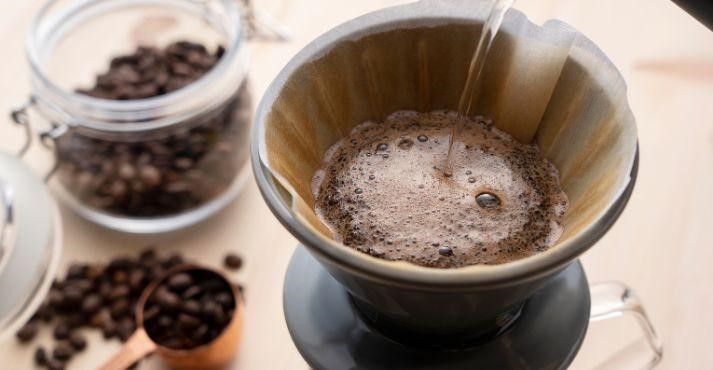
Pour-over coffee has captivated coffee lovers worldwide with its exceptional flavor and the level of control it offers.
This manual brewing method produces a cleaner and more nuanced cup of coffee and transforms the act of making coffee into a rewarding and meditative experience.
Let’s explore why pour-over coffee is a top choice for those who appreciate the art of coffee brewing.
1. Flavor and Quality
One of the main reasons to choose pour-over coffee is the superior flavor and quality it offers. The pour-over method allows for a cleaner, more nuanced coffee by completely controlling the brewing process.
Hot water poured over the coffee grounds in a pour-over coffee filter extracts the flavors, highlighting the beans’ unique characteristics.
This method ensures that the coffee’s natural oils and aromas are preserved, resulting in a bright, flavorful cup.
The slow, steady pour ensures even extraction, which reduces bitterness and boosts the overall taste.
This precise brewing process allows coffee enthusiasts to enjoy the best pour-over coffee possible, with every cup showcasing the beans’ full flavor potential.
2. Control and Precision
Another significant advantage of pour-over coffee is its level of control and precision. You can adjust various variables to suit your taste preferences when making pour-over coffee. This includes:
- Water temperature: Using water at the optimal pour-over coffee temperature (around 200 degrees Fahrenheit or 93 degrees Celsius) ensures proper flavor extraction without burning the coffee grounds.
- Pour rate: The speed at which you pour the water affects the extraction process. A slow, steady pour allows for more even extraction, while a faster pour can result in a more potent, more intense brew.
- Grind size: Adjusting the grind size of your coffee beans can significantly impact the taste. A finer grind increases the surface area for extraction, while a coarser grind results in a milder flavor.
- Coffee-to-water ratio: By experimenting with different coffee-to-water ratios, you can find the perfect balance for your desired strength and flavor.
This control allows you to create a personalized brew that perfectly matches your preferences, making pour-over coffee a favorite among coffee connoisseurs who appreciate the art of coffee making.
3. Aesthetic and Experience
Beyond flavor and control, pour-over coffee offers an aesthetic and experiential appeal that differentiates it from other brewing methods.
The process of making pour-over coffee is often described as ritualistic and meditative. From heating the water to the precise pouring technique, each step requires focus and attention, creating a sense of mindfulness.
The pour-over coffee dripper’s simple, elegant design and manually brewing coffee can be a calming and enjoyable experience.
This ritualistic aspect of pour-over coffee develops the coffee experience, transforming it from a routine task into a moment of relaxation and enjoyment.
The equipment’s aesthetic appeal, with its clean lines and minimalist design, adds to the pleasure of brewing and savoring each cup.
Equipment Needed for Pour-Over Coffee
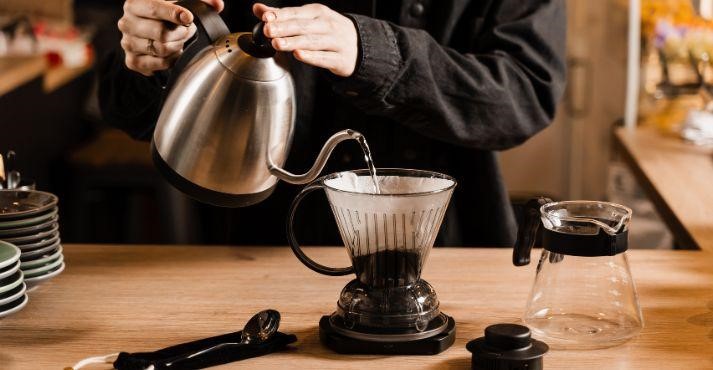
Making pour-over coffee requires a few special tools. Each piece of equipment ensures you get the best possible cup of coffee. Let’s look at what you need and why each item is essential.
1. Coffee Dripper
The pour-over coffee dripper is the device that holds your coffee grounds and filter. There are several types to choose from:
- Hario V60: This dripper has a cone shape with spiral ridges on the inside. It’s popular because it allows for fast and even extraction.
- Chemex: This dripper looks like a glass flask and uses thicker filters. It brews a clean and smooth cup of coffee.
- Kalita Wave: This dripper has a flat bottom with three small holes. It’s great for beginners because it’s more forgiving and provides a consistent brew.
The Hario V60 and Chemex in Southeast Asia are trendy choices among coffee enthusiasts.
2. Filters
The pour-over coffee filter is another critical component. The type of filter you use can affect the flavor of your coffee:
- Paper filters are the most common and provide a clean taste by trapping oils and fine ground.
- Metal filters: These are reusable and let more oils through, giving the coffee a richer flavor.
- Cloth filters are less common but can produce a smooth cup with a bit more body than paper filters.
Choosing the right filter is essential for getting the flavor you prefer in your coffee.
3. Kettle
A gooseneck kettle is ideal for making pour-over coffee. Its long, narrow spout gives you precise control over the water flow.
This precision is crucial for even extraction and allows you to control the pour-over coffee temperature more effectively. Consistent water temperature and pour rate help achieve the best pour-over coffee.
4. Grinder
A good quality burr grinder is essential for achieving the correct grind size for pour-over coffee. Unlike blade grinders, burr grinders crush the beans evenly, resulting in a consistent grind size.
This consistency is critical to ensuring even extraction and avoiding over- or under-extraction.
Freshly ground coffee makes a big difference in flavor, and using a burr grinder will help you get the most out of your beans.
5. Scale
Using a digital scale ensures you measure your coffee and water accurately. The coffee-to-water ratio is crucial for making a balanced cup of coffee.
A scale helps you measure the amount of coffee grounds and water needed for your brew. This precision helps you replicate and adjust your favorite recipes to suit your taste.
Step-by-Step Guide to Making Pour-Over Coffee
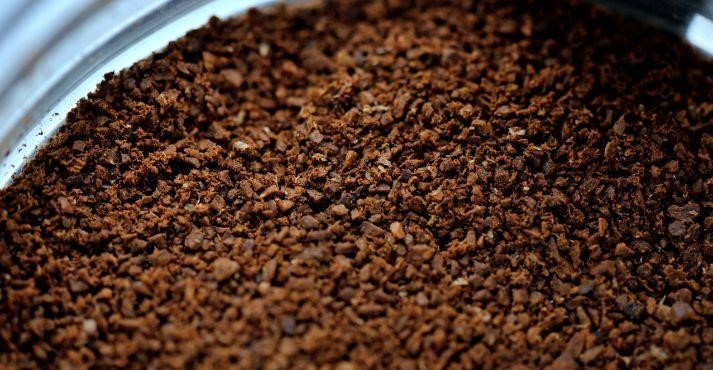
Making pour-over coffee is fun and rewarding. Follow these simple steps to brew a delicious cup of coffee at home.
1. Preparation
Start by preparing all your equipment and ingredients. Place your pour-over coffee dripper on top of your carafe or mug. Insert a pour-over coffee filter into the dripper and rinse it with hot water. This removes any paper taste and preheats the dripper.
Discard the rinse water. Also, preheat your carafe or mug by swirling hot water, then discard it. Now, you’re ready to start brewing!
2. Grinding the Coffee
The grind size of your coffee is significant for pour-over coffee. For this method, you need a medium-coarse grind similar to sea salt.
Use a burr grinder to achieve a consistent grind size. If you need clarification on the grind size, many video tutorials available online can help you see what it should look like. Freshly ground coffee will always give you the best flavor.
3. Measuring Coffee and Water
A good coffee-to-water ratio starting point is 1:16. This means that for every 1 gram of coffee, you’ll need 16 grams of water.
For example, if you’re using 25 grams of coffee, you’ll need 400 grams of water. Use a digital scale to measure both the coffee and water accurately. This precision helps ensure a balanced and tasty cup of coffee.
4. The Pouring Technique
The pouring technique is crucial for pour-over coffee. Here’s how to do it:
- Bloom phase: Start by pouring a small amount of water (about twice the weight of the coffee) over the grounds. This wetting process allows the coffee to “bloom” and release gases. Let it sit for about 30 seconds.
- Main pour: After the bloom, slowly pour the remaining water in a spiral motion, starting from the center and moving outward, then back to the center. Pour steadily and evenly to ensure all the grounds are saturated.
- Final pour: If needed, add a final pour to reach your desired coffee volume. Make sure to pour slowly and evenly to maintain consistent extraction.
5. Brewing Time and Adjustments
The total brewing time for pour-over coffee is usually around 3 to 4 minutes. You can adjust the brewing time if your coffee tastes too weak or too strong.
For a more robust cup, grind the coffee finer or pour it more slowly. For a milder cup, grind it coarser or pour it more quickly. Experiment with different brewing times and techniques to find what best suits your taste.
By following these steps, pour into your favorite coffee mug, and you’ll be able to make a delicious cup of pour-over coffee that highlights the unique flavors of your beans.
Popular Pour-Over Coffee Drippers
When it comes to pour-over coffee, the dripper you choose can make a big difference in the flavor and quality of your brew. Here are three popular drippers that are highly regarded by coffee enthusiasts around the world.
Hario V60
The Hario V60 is a favorite among pour-over coffee fans. This dripper has a distinctive cone shape with spiral ridges on the inside. These ridges help evenly guide the water through the coffee grounds, promoting a balanced extraction.
The V60’s design allows for a quick and even brew, which brings out the best flavors in coffee. Many people love the Hario V60 because it gives them control over the brewing process, making it easy to adjust the coffee-to-water ratio and pouring technique.
This dripper is available in various materials, including ceramic, glass, and plastic, each offering different heat retention properties.
Chemex
Another popular choice is the Chemex, known for its elegant design and exceptional coffee clarity. The Chemex dripper resembles a glass flask and uses thick, bonded paper filters that remove most coffee oils and fine particles.
This results in a clean and smooth cup of coffee with a bright flavor profile. The Chemex’s design makes it a stylish addition to any kitchen and enhances the coffee experience.
The brewing process with the Chemex is straightforward, and the resulting coffee is often described as crisp and pure. This makes it a favorite for those who appreciate a clear and flavorful brew.
Kalita Wave
The Kalita Wave is recognized for its flat-bottom design, which sets it apart from other drippers. This design features three small holes at the bottom of the dripper, ensuring an even extraction by distributing the water more uniformly over the coffee grounds.
The Kalita Wave is exceptionally user-friendly, making it an excellent choice for beginners and experienced brewers. Its flat-bottom design reduces the chances of over-extraction, resulting in a consistently well-balanced cup of coffee.
The Kalita Wave is available in stainless steel, glass, and ceramic, providing various options to suit different preferences.
These pour-over coffee drippers offer unique features and benefits, allowing you to enjoy the best pour-over coffee experience tailored to your taste and style.
Drip Coffee vs. Pour-Over
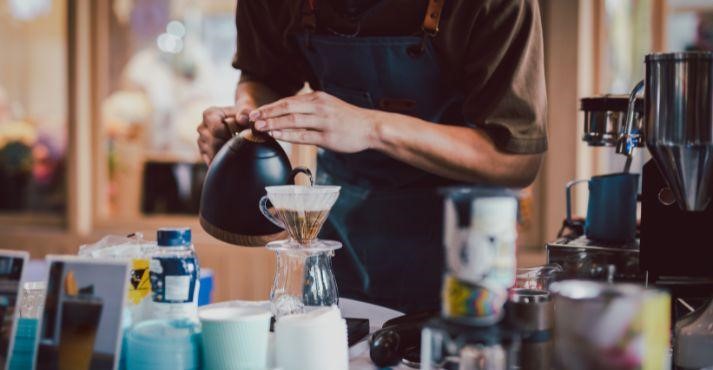
Choosing between drip coffee and pour-over coffee can depend on your flavor, control, and convenience preferences. Both methods have their unique qualities and can cater to different coffee lovers.
Difference of Method
- Drip Coffee: Drip coffee machines automate the brewing process. You add water and coffee grounds, press a button, and the machine does the rest. It’s convenient and consistent but offers little control over the brewing variables.
- Pour-Over Coffee: This method is manual, giving you full control over factors like the coffee-to-water ratio, pour-over coffee temperature, and pouring technique. You can adjust these variables to perfect your brew.
Flavor Profile and Quality
- Drip Coffee: The automated process can sometimes produce a less nuanced flavor. While convenient, it only sometimes highlights the unique characteristics of the coffee beans.
- Pour-Over Coffee: Pour-over enthusiasts appreciate the increased clarity and complexity of flavors. The manual process allows for even extraction, producing a cleaner and brighter cup of coffee.
Equipment and Ease of Use
- Drip Coffee: A drip coffee machine is required, which is easy to use and consistent. Add water and coffee and let the machine do the work. It is ideal for busy mornings when convenience is critical.
- Pour-over coffee requires a pour-over coffee dripper, a pour-over coffee filter, a gooseneck kettle, and a scale. While it takes more time and effort, the process is rewarding and provides hands-on experience.
Drip coffee offers simplicity and convenience, making it great for those who want a quick and easy brew. In contrast, pour-over coffee provides control and a richer flavor profile, perfect for coffee lovers who enjoy the art of brewing.
Conclusion
Now that we know what pour-over coffee is, we can truly appreciate its flavor and experience. It is a fantastic brewing method that offers unmatched control and flavor.
Whether using a pour-over coffee dripper like the Hario V60, Chemex, or Kalita Wave, each cup you brew can be customized to your taste. The manual process allows for a cleaner and more nuanced cup, highlighting the unique characteristics of your coffee beans.
While it requires more effort and equipment, the rewarding experience and superior flavor make it worth it.
If you’re passionate about coffee and enjoy the brewing process, pour-over coffee is worth trying.





